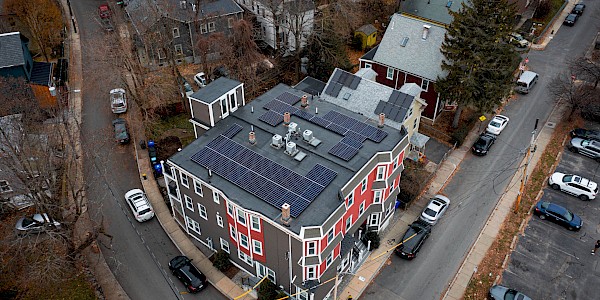How Does the Federal Solar Tax Credit Work?
Published on Ownerly.com
Solar energy is a great way for homeowners to save money on energy bills, but you might also qualify for a federal solar tax credit. Find out how this tax credit works.
In this article:
Whether you want to reduce consumption or save on electricity , solar panels are an increasingly popular option for eco-friendly homeowners.
While solar panel installation isn’t cheap, the government offers incentives to make these systems more affordable. One popular benefit, the federal solar tax credit, may be an appealing option. Here’s how the federal solar tax credit works and how to determine if you qualify.
Understanding the federal solar tax credit
According to the Office of Energy Efficiency & Renewable Energy, installations of US solar panels have grown 35 times since 2008. As technology improves, the price tag continues to go down, dropping by almost 50% over the past seven years.
“Making the investment allows you to take control of energy costs while supporting good local jobs and reducing your environmental impact,” said Daniel Mello Guimaraes, CEO and co-founder of The Boston Solar Company, the largest solar panel installer in Massachusetts.
The federal solar tax credit makes installing solar panels more affordable by letting you claim a tax credit for part of the expense on your federal tax return.
“The solar energy tax credit is valuable because it is a dollar for dollar off-set against tax liability, helping to pay back the initial investment in solar energy,” said Mello Guimaraes.
According to the Center for Sustainable Energy, the average 5-kW residential solar panel system costs $15,000 to $25,000 before incentives. While this upfront expense is steep, the federal solar tax credit could ease some of the burden. You can claim a federal tax credit of up to 26% on your solar panels, with no limit on the cost of your system.
At the end of 2020, Congress passed an end-of-year spending bill, including an extension for the federal solar tax credit. You can now claim up to 26% through the end of 2022. The deduction drops to 22% in 2023 and won’t be available for homeowners in 2024.
Commercial and industrial properties may still claim 10% after the residential credit expires.
How to qualify for the solar tax credit
If you are considering the federal solar tax credit, you will want to make sure you qualify before spending the money. Luckily, claiming the tax credit may be easier than you expect.
“Generally, anyone who owns a home and pays federal income taxes is eligible for the credit,” said Mello Guimaraes. A reputable solar panel installer can confirm that your equipment and installation qualify.
To be eligible for the federal solar tax credit, you must install a new system by the deadline at the end of 2023. You must own your solar panel system, rather than lease it. The solar panel system can be at your primary or secondary residence in the United States. It may also be part of an off-site community solar project, generating up to the amount of electricity your home uses.
You may claim the following expenses:
- Solar panels or cells to power an attic fan
- Labor costs for solar panel installation
- Balance-of-system equipment
- Energy storage devices for the solar panel system only
- Sales tax paid for eligible expenses
You may read more about the specifics here , but if you’re unclear about what qualifies, don’t hesitate to seek professional guidance. “We always recommend speaking with a tax professional to determine how solar energy tax incentives apply to your situation,” said Mello Guimaraes.
How to claim the federal solar tax credit
After confirming that you qualify, you can begin the process. Start by compiling your itemized installation receipts. You will need these receipts to claim the credit on your tax return.
You can claim the federal solar tax credit on Form 5695 , which attaches to Schedule 3 . After using Form 5695 to calculate your tax credit, you can enter the number on line 5 of Schedule 3. There are instructions for Form 5695 here , but it’s easy to get confused, so don’t hesitate to contact a tax professional.

Other solar tax credits
In addition to the federal solar tax credit, you may qualify for other incentives. These incentives and tax credits will vary based on where you live.
State tax credits
Depending on where you live, you could be eligible for state tax credits. Like the federal solar tax credit, these incentives could lower your tax bill and offset some of the upfront cost.
Local rebates
You may also qualify for local solar rebates through your city, state, utility company or local nonprofit organizations. While some rebates may be temporary, EnergySage estimates they could reduce your solar panel system by another 10% to 20%.
Some states and local utility companies offer performance-based incentives (PBIs) to solar panel system owners. Typically, you can earn incentives based on the electricity your system generates, measured by kilowatt-hour credits.
Solar renewable energy certificates (SRECs)
As some states embrace clean energy, local lawmakers have passed solar-friendly legislation, requiring their state to generate a certain percentage of their electricity from solar. These states offer solar renewable energy certificates (SRECs), which you can sell to local utility companies. According to EnergySage, SRECs could generate hundreds to thousands of dollars per year, depending on your local market.
How to find other solar credits and incentives
An experienced solar panel installer should be well-versed in local incentives, but you may also want to do some research. EnergySage offers a list of solar rebates and incentives by state, and The North Carolina Clean Energy Technology Center has the Database of State Incentives for Renewables & Efficiency (DSIRE) .
Be proactive to claim the solar tax credit
If you are ready for solar panels, the federal solar tax credit could make your installation more affordable. You may also explore local incentives, which could slash the price even further.
“There has never been a better time to look into solar energy options,” Mello Guimaraes said. “The technology continues to get more efficient and cost-effective every year.”
But before hiring an installer, be sure to ask questions. You may also speak with a tax professional to make sure you qualify for the incentives you expect. If you decide to move forward, save itemized receipts of every installation expense. You will need those at tax time and for your records.
Disclaimer: The above is solely intended for informational purposes and in no way constitutes legal advice or specific recommendations.




